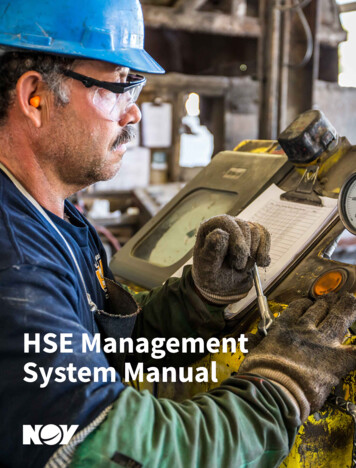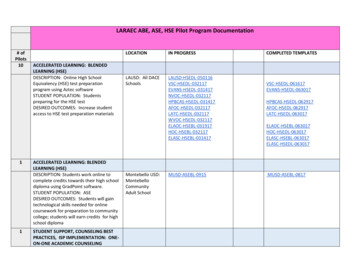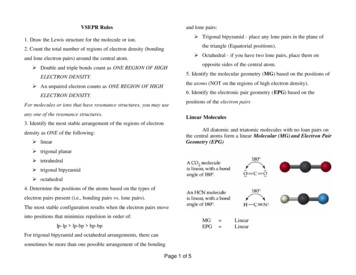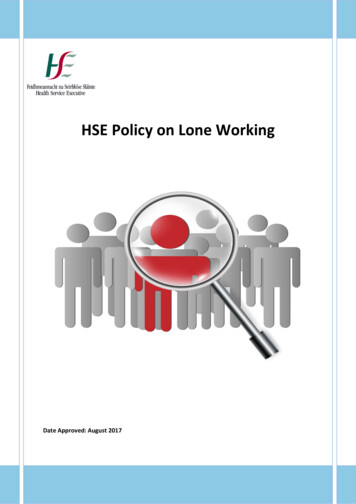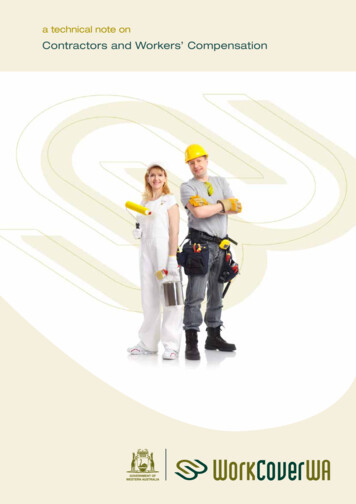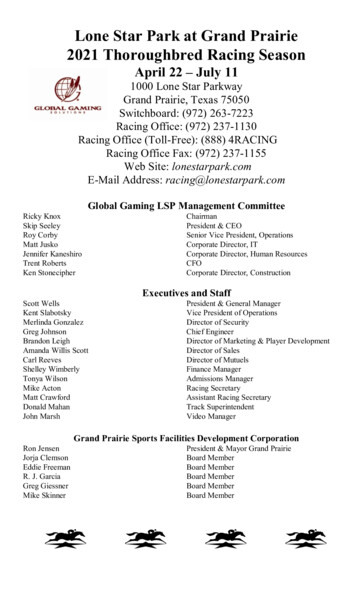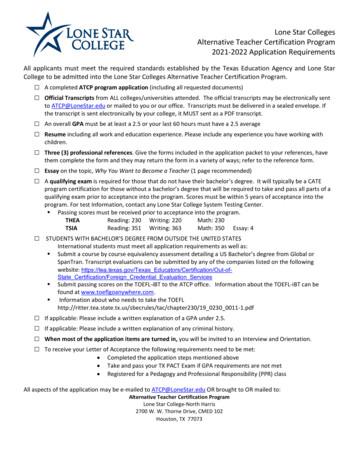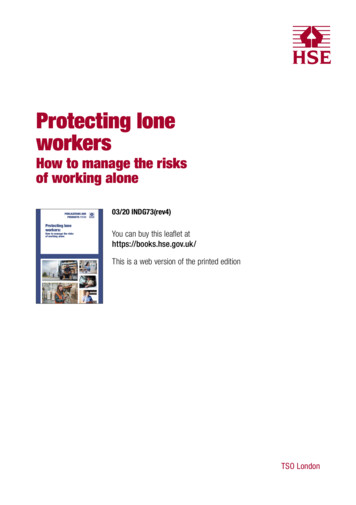
Transcription
Protecting loneworkersHow to manage the risksof working alone03/20 INDG73(rev4)Protecting loneworkers:You can buy this leaflet athttps://books.hse.gov.uk/How to manage the risksof working aloneThis is a web version of the printed edition11877 INDG73 Protecting lone workers v1 0.indd 125/02/2020 14:48TSO London
Protecting lone workers: How to control the risks of working aloneThis guidance explains how to keep lone workers healthy and safe. It isfor anyone who employs lone workers, or engages them as contractorsetc, including self-employed people or those who work alone.Lone workers face the same hazards at work as anyone else, butthere is a greater risk of these hazards causing harm as they maynot have anyone to help or support them if things go wrong.As an employer, you should provide training, supervision, monitoringand support for lone workers.Who are lone workers and what jobs do they do?A lone worker is ‘someone who works by themselves without close ordirect supervision’. They exist in all sectors and include those who:work alone at a fixed base, for example in shops, petrolstations, factories, warehouses or leisure centres; work separately from other people on the same premises oroutside normal working hours, for example security staff,cleaners, maintenance and repair staff; work at home; work away from a fixed base, such as:– health, medical and social care workers visiting people’shomes etc;– workers involved in construction, maintenance and repairincluding engineers, plant installation and cleaning workers;– engineers, assessors and delivery drivers of equipment andsupplies who attend construction projects;– service workers, including postal staff, taxi drivers,engineers, estate agents, and sales or servicerepresentatives visiting domestic and commercial premises;– delivery drivers including HGV drivers, van driver/couriersand car/bike-based couriers;– agricultural and forestry workers; 2are volunteers carrying out work on their own, for charities orvoluntary organisations (fundraising, litter-picking etc). Moreinformation is available at: www.hse.gov.uk/voluntary/
Protecting lone workers: How to control the risks of working aloneChanging ways of workingWays of working are changing with automation and greater use oftechnology. Types of workers are also changing, for example peopleare working until they are older. This means employers need to thinkdifferently when considering how to keep them healthy and safe.The gig economy is also increasing and features short-term, informalworking relationships where work is generally: on-demand;obtained through an online platform;delivered on a task-by-task basis.These workers are usually independent contractors, freelancers orself-employed. Many are lone workers, working to deadlines andexposed to specific road risks for work-related journeys.Equally, lone HGV drivers are likely to experience long, unsociablehours, high physical and mental demands, and often long periods ofsedentary work. Employers should monitor drivers’ health regularlyand adapt their work to accommodate any individual health needs.All of these factors can have adverse health consequences for workers,such as musculoskeletal disorders, stress, tiredness and fatigue, aswell as issues associated with poor or irregular eating habits.Health and safety lawThe guidance in this leaflet will help you, as an employer,understand what you should do to comply with your legal dutiestowards all lone workers under: the Health and Safety at Work etc Act;the Management of Health and Safety at Work Regulations.3
Protecting lone workers: How to control the risks of working aloneIs it legal to work alone and is it safe?You are responsible for the health, safety and welfare at work of allyour workers, and this applies to any contractors, volunteers or selfemployed people. These responsibilities cannot be transferred toany other person, including to those people who work alone.It will often be safe to work alone. However, the law requires you tothink about and deal with any health and safety risks before peopleare allowed to do so.Establishing a healthy and safe working environment for loneworkers can be different from organising the health and safety ofother workers. Some things to consider in ensuring lone workersare not put at risk include: assessing areas of risk including violence, manual handling,the medical suitability of the individual to work alone andwhether the workplace itself presents a risk to them;requirements for training, levels of experience and how best tomonitor and supervise them;having systems in place to keep in touch with them andrespond to any incident.Employees and some self-employed workers also haveresponsibilities to take reasonable care of themselves and otherpeople affected by their work activities and to co-operate with theiremployers in meeting their legal obligations. See the ‘Responsibilitiesof workers’ section towards the end of this leaflet.Managing the risksThe law says that employers must assess and control the risks intheir workplace.You must think about what might cause harm to people and decidewhether you are doing enough to prevent that harm. If you employfive or more workers, you must write down what you’ve found.4
Protecting lone workers: How to control the risks of working aloneThat record should include: the hazards (things that may cause harm);how they may harm people;what you are already doing to control the risks.You must review and update this record, for example if anythingchanges.There is no legal requirement to conduct a specific, separate riskassessment for lone workers. However, you have a duty to includerisks to lone workers in your general risk assessment and takesteps to avoid or control risks where necessary. This must include: involving workers when considering potential risks andmeasures to control them;taking steps to ensure risks are removed where possible, orputting in place control measures, for example by carefullyselecting work equipment to ensure the worker can performwhat is required safely;instruction, training and supervision;reviewing risk assessments periodically and updating themafter any significant changes, such as new staff, processesor equipment;when the lone worker is working at another employer’sworkplace, consulting with that employer to identify any risksand required control measures.Risk assessment should help you decide on the right level ofsupervision for lone workers. There are some high-risk activitieswhere at least one other person may need to be present. Examplesinclude working: in a confined space, where a supervisor may need to bepresent, along with someone dedicated to the rescue role;near exposed live electricity conductors;in diving operations, vehicles carrying explosives or fumigation.5
Protecting lone workers: How to control the risks of working aloneYou should take account of normal work and foreseeableemergencies such as fire, equipment failure, illness and accidents.Consider how to control the risks by thinking about who will beinvolved, where the work will happen and what triggers might bemore of an impact for lone workers.More advice on managing risks is available at: www.hse.gov.uk/simple-health-safety/risk/The lone worker and other peopleYou should consider the lone worker, the people they may come intocontact with, the work they are carrying out, and how this mayimpact on the risk: How experienced is the worker in their role and in working alone?Has the worker received relevant training?Are there any reasons why the worker might be morevulnerable, for example are they young, pregnant, disabled ora trainee?Environment and equipmentConsider the environment the worker is in and the equipment theyare using: 6Does the workplace present a specific risk to the worker, suchas operating equipment alone or lifting objects too large forone person?Is the work in a rural or isolated area?Is the worker going into someone else’s home or premises?Is there a safe way in or out for one person working outsidenormal hours?Does the worker have adequate and reliable means ofcommunication and a way to call for help?
Protecting lone workers: How to control the risks of working aloneHow could the work trigger an incident?Consider the activity being carried out by a lone worker and how itmight trigger an incident: Is the work a security role, for example having authority overcustomers and enforcing rules?Does the work involve handling cash, asking for payment orremoving goods or property?Stress, mental health and wellbeingLone working can negatively impact on employees’ work-relatedstress levels and their mental health.For example, the Stress Management Standards include factorssuch as relationships with, and support from, other workers andmanagers. If these are not managed properly, they can lead towork-related stress. Being away from managers and colleaguescould mean good support is more difficult to achieve.Putting procedures in place that allow direct contact between thelone worker and their manager can help. Managing work-relatedstress relies on understanding what is ‘normal behaviour’ for anemployee and recognising abnormal behaviour or symptoms at anearly point (www.hse.gov.uk/stress/signs.htm).If contact is poor, employees may feel disconnected, isolated orabandoned, which can affect their performance and potentially theirstress levels or mental health.Keeping contact with lone workersYou should: agree how to keep in touch with lone workers through regularmeetings, or provide other opportunities to share concerns;include lone workers in social events and work or team updates;7
Protecting lone workers: How to control the risks of working alone ensure lone workers are included in any consultation onchanges – they may have unique implications for them;make sure lone workers are included in any training thatis required.You can find advice on consulting workers at: ng support on mental healthWork can also aggravate pre-existing conditions, and problems atwork can bring on symptoms or make their effects worse. Whetherwork is causing the health issue or aggravating it, you have a legalresponsibility to help your employees.Work-related mental health issues must be assessed to measurethe levels of risk to staff. Where a risk is identified, you must takesteps to remove it or reduce it as far as reasonably practicable.If a lone worker has a pre-existing mental health condition, you mayneed to make reasonable adjustments to their work or workplaceand this may require additional interventions, including thoserequired by the Equality Act age-guide/employment-workplace-adjustmentsYou can find work-related mental health advice on HSE’s website rk-related violenceAny form of violence against workers is unacceptable and mayaffect their psychological as well as their physical health.Lone working does not automatically imply a higher risk of violence,but it does make workers more vulnerable. The lack of nearbysupport from a colleague means that lone workers may be less ableto prevent an incident from occurring.8
Protecting lone workers: How to control the risks of working aloneSome of the key violence risks in the workplace can include: working in locations where there is a known high risk of violence;late evening or early morning work when there are fewerworkers around;when workers, such as security staff, hold positions ofauthority over customers or clients;alcohol and drug use by clients or members of the public loneworkers have contact with;carrying money and/or valuable equipment.Training in personal safety, which may include conflict resolution,can help a worker recognise situations where they may be at riskand to take appropriate steps to avoid or manage the risk.Other measures to consider include modification or design of thework environment, if appropriate, to avoid workers being isolatedand providing work equipment such as devices designed to raisethe alarm in an emergency which can be operated manually orautomatically, eg phones or radios.Employers should have measures in place to support any worker whohas been subject to an abusive or violent incident – workers shouldalso play an important part in identifying and reporting incidents.The consequences of violence to lone workers can impact onbusinesses in several ways including staff turnover, low productivityand damage to business reputation.The impact of violence on a lone worker can lead to work-relatedstress, which may have serious and long-term effects on theirpsychological, physical and mental health.HSE’s work-related violence website includes advice and casestudies on preventing violence towards lone workers:www.hse.gov.uk/violence/9
Protecting lone workers: How to control the risks of working aloneWhat if a lone worker’s first language is not English?If a lone worker’s first language is not English, you shouldensure that suitable arrangements are in place to provide clearcommunications, especially in an emergency.Workers from outside the UK may encounter unfamiliar risks in the jobsthat they do and in a working environment with a workplace culturethat may be very different from that of their country of origin.You must ensure workers have received and understood theinformation, instruction and training they need to work safely.There is more information at: www.hse.gov.uk/migrantworkers/about.htmCan someone work alone if they have amedical condition?You should seek medical advice if necessary. Consider both routinework and foreseeable emergencies that may put additional physicaland mental burdens on an individual.What if a person becomes ill, has an accident, orthere is an emergency?Your assessment of the risks should identify foreseeable events.Emergency procedures should be established, put in place andemployees should be trained in them.Regular and realistic practice should take place to allow quick andeffective action to ease the situation and reduce the consequences.Your risk assessment may indicate that some lone workersshould carry first aid equipment and/or may need first aid training(including how to administer first aid to themselves). They shouldalso have access to adequate first aid facilities.10
Protecting lone workers: How to control the risks of working aloneEmergency procedures should also include appropriate guidance onhow and when lone workers can contact their employer.More information on first aid is available at: www.hse.gov.uk/simple-health-safety/firstaid/What if a lone worker is working from home?You have the same responsibility for the safety and health ofemployees who work from home as for any other employees.This means providing supervision, education and training, as well asimplementing enough control measures to protect the homeworker.You should accept liability for accident or injury of a homeworker asfor any other employee.TrainingTraining is important where there is limited supervision to control,guide and help in uncertain situations. It may also be crucial inenabling people to cope in unexpected circumstances and withpotential exposure to violence and aggression.Lone workers are usually unable to ask more experienced colleaguesfor help, so extra training may be appropriate. They need to besufficiently experienced and fully understand the risks andprecautions involved in their work and the location that they workin. Training should be relevant to the work activity.You should set the limits to what can and cannot be done whileworking alone. Ensure workers are: competent to deal with the requirements of the job;suitably trained in the use of any technical solutions provided;able to recognise when to seek advice from elsewhere.11
Protecting lone workers: How to control the risks of working aloneSupervisionThe extent of supervision required depends on the risks involvedand the ability of the lone worker to identify and handle health andsafety issues.The level of supervision needed is a management decision, whichshould be based on the findings of a risk assessment – the higherthe risk, the greater the level of supervision required.Lone workers may need to be accompanied at first where they are: new to a job;undergoing training;doing a job that presents specific risks;dealing with new situations.Monitoring and keeping in touchTechnology advances mean there is a wide range of systems anddevices available to employers to monitor lone workers.Any monitoring system needs to be embedded into an organisationso it is well understood by workers. You must put clear proceduresin place because effective means of communication are essential.These may include: 12supervisors periodically visiting and observing peopleworking alone;pre-agreed intervals of regular contact between the loneworker and employer, using phones, radios, email etc, bearingin mind the worker’s understanding of English;other devices designed to raise the alarm in an emergencywhich can be operated manually or automatically;implementing a robust system to ensure a lone worker hasreturned to their base or home once their work is completed.
Protecting lone workers: How to control the risks of working aloneYou should regularly test technical solutions and all emergencyprocedures to ensure lone workers can be reached or contacted if aproblem or emergency is identified.Responsibilities of workersWorkers have a duty to take care of their own health and safety andthat of others who may be affected by their actions at work. Theymust co-operate with employers and co-workers to help everyonemeet their legal requirements.If workers have specific queries or concerns relating to healthand safety in their workplace, they should talk to their employer,manager/supervisor or a health and safety representative.Some employers use dynamic risk assessments for lone workingsituations. This is where workers themselves make operationaldecisions based on risks which cannot necessarily be foreseen. Thisis not a substitute for a comprehensive risk assessment.When a risk assessment identifies circumstances where a loneworker may have to undertake a dynamic risk assessment, they must: receive training on how to make that assessment;consider the range of possible control measures and whataction to take;get support for their decisions.If they’re self-employedHealth and safety law may not apply to them but they will need tocheck at ays.htmAs their employer (for example, if you have contracted them towork on your premises) you will still be responsible for their healthand safety.13
Protecting lone workers: How to control the risks of working aloneFind out moreHomeworkers: Guidance for employers on health and safety LeafletINDG226(rev1) HSE 2011 www.hse.gov.uk/pubns/indg226.pdfManual handling. Manual Handling Operations Regulations 1992 (asamended). Guidance on Regulations L23 (Third edition) HSE 2004www.hse.gov.uk/pubns/books/l23.htmViolence at work: A guide for employers Leaflet INDG69(rev) HSE1996 www.hse.gov.uk/pubns/indg69.pdfDriving at work: Managing work-related road safety LeafletINDG382(rev1) www.hse.gov.uk/pubns/indg382.pdfManaging work-related violence in licensed and retail premisesLeaflet INDG423 HSE 2008 www.hse.gov.uk/pubns/indg423.pdfStress at work – Mental health conditions: www.hse.gov.uk/stress/Working in confined spaces: www.hse.gov.uk/toolbox/confined.htmWorking with substances hazardous to health: A brief guide toCOSHH Leaflet INDG136(rev5) HSE 2012 www.hse.gov.uk/pubns/indg136.htmWorking at height: www.hse.gov.uk/toolbox/height.htm and Workingat height: A brief guide Leaflet INDG401(rev2) www.hse.gov.uk/pubns/indg401.htmAdvice for self-employed he-law-says.htmOther sources of adviceYou may find more information from trade associations oremployers’ organisations, or from trade unions and some charities,eg the Suzy Lamplugh Trust at www.suzylamplugh.org14
Protecting lone workers: How to control the risks of working aloneAge, Health and Professional Drivers’ Network – a networkpromoting best practice in the transport er informationFor information about health and safety visit https://books.hse.gov.ukor http://www.hse.gov.uk. You can view HSE guidance online andorder priced publications from the website. HSE priced publicationsare also available from bookshops.To report inconsistencies or inaccuracies in this guidance email:commissioning@wlt.comThis guidance is issued by the Health and Safety Executive.Following the guidance is not compulsory, unless specifically stated,and you are free to take other action. But if you do follow theguidance you will normally be doing enough to comply with the law.Health and safety inspectors seek to secure compliance with thelaw and may refer to this guidance.This leaflet is available in packs from HSE BooksISBN 978 0 7176 6729 1.A web version can be found at www.hse.gov.uk/pubns/indg73.htm Crown copyright 2020Any enquires regarding this publication should be sent to:copyright@hse.gov.uk. First published 03/20.15
Further informationFor information about health and safety visit https://books.hse.gov.uk orhttp://www.hse.gov.uk.You can view HSE guidance online and order priced publications from thewebsite. HSE priced publications are also available from bookshops.To report inconsistencies or inaccuracies in this guidance emailcommissioning@wlt.com.This guidance is issued by the Health and Safety Executive. Following theguidance is not compulsory, unless specifically stated, and you are free totake other action. But if you do follow the guidance you will normally bedoing enough to comply with the law. Health and safety inspectors seek tosecure compliance with the law and may refer to this guidance.This leaflet is available in packs from HSE Books ISBN 978 0 7176 6729 1.A web version can be found at www.hse.gov.uk/pubns/indg73.htm. Crown copyright If you wish to reuse this information, any queriesregarding this publication should be sent to copyright@hse.gov.ukFirst published 03/2003/20 INDG73(rev4)Published with the permission of the Healthand Safety Executive on behalf of the Controllerof Her Majesty’s Stationery Office.www.tso.co.ukhttps://books.hse.gov.uk/
You must review and update this record, for example if anything changes. There is no legal requirement to conduct a specific, separate risk assessment for lone workers. However, you have a duty to include risks to lone workers in your general risk assessment and take steps to avoid or control risks where necessary. This must include:
